
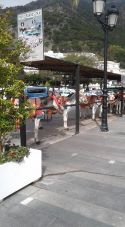 Reconquista. We also visited a small town nearby, (note the burro taxi) where our guide got us into a museum featuring Picasso ceramics. Picasso was born here.
Reconquista. We also visited a small town nearby, (note the burro taxi) where our guide got us into a museum featuring Picasso ceramics. Picasso was born here.Exploring International Business with Illinois Wesleyan's Fred Hoyt

 Reconquista. We also visited a small town nearby, (note the burro taxi) where our guide got us into a museum featuring Picasso ceramics. Picasso was born here.
Reconquista. We also visited a small town nearby, (note the burro taxi) where our guide got us into a museum featuring Picasso ceramics. Picasso was born here.
Cordoba.. the great mosque with the cathedral inside, Roman bridge, and birthplace of Maimonides. We were in the mosque turned cathedral when word came that it was closing tomorrow for 2 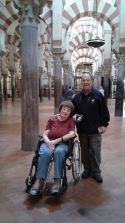 weeks (as we thought
weeks (as we thought 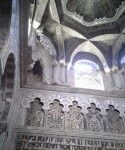 optimistically at the time). In fact, COVID was causing Spain itself to shut down.
optimistically at the time). In fact, COVID was causing Spain itself to shut down.
Our trip to Granada was canceled and we sped to Malaga, where we were supposed to catch our flight home. We were now in the hands of our travel agent. Carolyn’s dream of Gibraltar and mine of Granada were thwarted as we 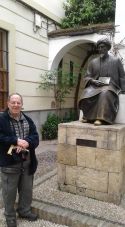 scrambled to get back to the US. Get us home, I pleaded, and left the details to our agent. Who knew it would be the end of our international travel?
scrambled to get back to the US. Get us home, I pleaded, and left the details to our agent. Who knew it would be the end of our international travel?
Seville
March 12, 2020
“Real” in Spanish means “royal”, and the “Real” Alcazar we saw today is real in both senses—regal (it’s the oldest continuously used palace in Europe) and the top of the line. Our guide pointed to it as one of the contributors to her story of Seville as a blend of the three world religions. I beg to correct her characterization, at least to a small degree.
One of those religions is reflected in the name of our hotel—Casas de la 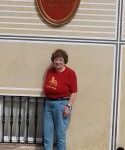 Juderia—the house of the Jews. True, it’s in the old Jewish Quarter, but there’ve been no resident Jews here since their expulsion from Castile in 1481 and Spain in 1492. There were none here during Muslim times either (the 500 years from 711 until the conquest in the 1248). The synagogue next door was demolished, and on its site sits the baroque church of Santa Maria la Blanca, complete with a painting by the 16th century local, Murillo, who refused to move to Madrid, and thus is still a local favorite. True, from 1248 the city housed the second largest Jewish population in Spain, and there’s at least one street named for a Levi, who was treasurer to the King of Castile. But the Sephardic museum that might have shed light on contributions that have lasted is undergoing renovations.
Juderia—the house of the Jews. True, it’s in the old Jewish Quarter, but there’ve been no resident Jews here since their expulsion from Castile in 1481 and Spain in 1492. There were none here during Muslim times either (the 500 years from 711 until the conquest in the 1248). The synagogue next door was demolished, and on its site sits the baroque church of Santa Maria la Blanca, complete with a painting by the 16th century local, Murillo, who refused to move to Madrid, and thus is still a local favorite. True, from 1248 the city housed the second largest Jewish population in Spain, and there’s at least one street named for a Levi, who was treasurer to the King of Castile. But the Sephardic museum that might have shed light on contributions that have lasted is undergoing renovations.
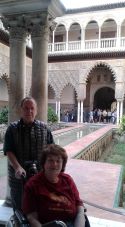
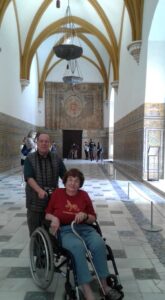 The “real Alcazar” does make a case for the blending of the Muslim and Catholic traditions, however. The original Alcazar is now mostly destroyed, having given way to a royal Christian palace on the same grounds, enlarged and embellished by successive Bourbon and Habsburg rulers. Today’s King stays here when he’s in town—in non-public quarters.
The “real Alcazar” does make a case for the blending of the Muslim and Catholic traditions, however. The original Alcazar is now mostly destroyed, having given way to a royal Christian palace on the same grounds, enlarged and embellished by successive Bourbon and Habsburg rulers. Today’s King stays here when he’s in town—in non-public quarters.
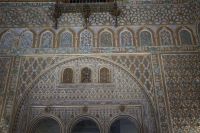 The public areas have a lot of artwork that reflects the Muslim influence; our guide said that Christian Pablo I, responsible for the rebuild in 1364, borrowed Muslim artists from Granada for the tiles that make the palace colorful. There’s even a word for Spanish architecture influenced by Islam—“Mudejar.” A later addition, however, added an altar and a Gothic wing; the gardens alone are 19 acres. And speaking of Gothic, the Cathedral, across
The public areas have a lot of artwork that reflects the Muslim influence; our guide said that Christian Pablo I, responsible for the rebuild in 1364, borrowed Muslim artists from Granada for the tiles that make the palace colorful. There’s even a word for Spanish architecture influenced by Islam—“Mudejar.” A later addition, however, added an altar and a Gothic wing; the gardens alone are 19 acres. And speaking of Gothic, the Cathedral, across 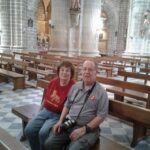 from the
from the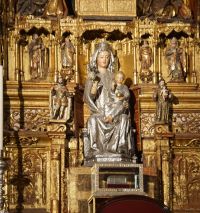 palace, is now the largest Gothic church in the world, and the third in size behind the Vatican and St. Paul’s in London. It is rectangular, having been built in the 1400s (started 1401, completed a century later) on the site of a mosque. The bell tower was once the minaret for the mosque, and its size indicates the mosque may well have
palace, is now the largest Gothic church in the world, and the third in size behind the Vatican and St. Paul’s in London. It is rectangular, having been built in the 1400s (started 1401, completed a century later) on the site of a mosque. The bell tower was once the minaret for the mosque, and its size indicates the mosque may well have 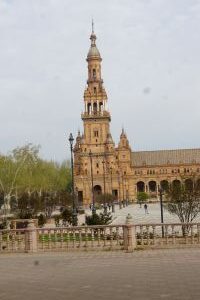 been one of the largest in the world as well.
been one of the largest in the world as well.
The Cathedral houses two artifacts that attest to the commercial importance of Seville. Before the local river silted, it was the main seaport facing the Atlantic, 60 miles upriver from the ocean. It was from here that the Admiral of the Ocean (Columbus) set sail for the New World, and it was to this Cathedral that eventually his bones returned (at least some of them, having rested in the Dominican Republic and Cuba at one time). It was from Seville that Magellan set sail around the world, too; of his 250 men, only 18 returned, under Captain Elcano. Magellan himself was eaten in the Philippines, I believe, so he’s only mentioned in the plaque indicating the voyage.
Two commercial sites we visited attest to the once-glory of Seville 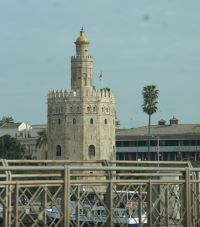 commercially. The Tower of Gold was one of the Muslim wall towers. It guarded the river and had a chain that blocked passage of enemies’ ships and charged (probably gold) for passage by friends, at least until Fernando III sailed in and broke through the chain, capturing the city. The Tower is still there.
commercially. The Tower of Gold was one of the Muslim wall towers. It guarded the river and had a chain that blocked passage of enemies’ ships and charged (probably gold) for passage by friends, at least until Fernando III sailed in and broke through the chain, capturing the city. The Tower is still there.
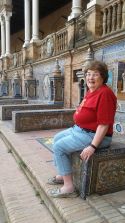 The other commercial site was the remains of an Iberia-American fair in 1929, ten years in the planning, that brought commercial exhibits and buildings from the former Spanish (and Portuguese) colonies in the New World. Many of them are still used by the countries that built them (the US consulate is in the US building, for example), but many of them are now government buildings or university buildings. The broad boulevards and parks remain as well. A similar fair in 1992, commemorating 500 years of Columbus’ expeditions, however, was more evanescent. The empty site allowed the local government to authorize a skyscraper because it was outside the central business district, where no building could be higher than the bell tower of the Cathedral.
The other commercial site was the remains of an Iberia-American fair in 1929, ten years in the planning, that brought commercial exhibits and buildings from the former Spanish (and Portuguese) colonies in the New World. Many of them are still used by the countries that built them (the US consulate is in the US building, for example), but many of them are now government buildings or university buildings. The broad boulevards and parks remain as well. A similar fair in 1992, commemorating 500 years of Columbus’ expeditions, however, was more evanescent. The empty site allowed the local government to authorize a skyscraper because it was outside the central business district, where no building could be higher than the bell tower of the Cathedral.
With a little more time, the one stop I would like to have made was at the Archeology Museum. While our guide wanted to reduce Seville to the three religions, there were at least two more periods I’d have liked to know more about. This was a Roman city for 500 years (or there was one nearby), and two emperors—Trajan and Hadrian—were born here, and the Visigoths swept in too, and our guide noted that the locals welcomed the Muslims in 711 in preference to the Christians. That might have made an interesting visit.
However, when we emerged, our guide told us that the Alhambra was closed tomorrow, that all museums were closed. I knew it was time to go home. We were lucky to have had an agent, who got us home before the curtain fell on travel in Europe.
March 11, 2020
Jerez enroute to Seville
22 hours of flights and airports, three movies, and over 4500 miles in the air, and we’re finally in Andalusia. Checking with my gps, however, discloses that we’re at the 37 th parallel, 3737 miles from home. And really out of touch with much news from the United States. I hadn’t realized that EU privacy laws, which changed last May, disabled most American news sources. I can get headlines, but when I click my usual sources–Trib/NYT/Wall Street Journal, and Pantagraph–I get a notice that they are banned from delivering content. And ESPN switches to the Spanish/European edition.
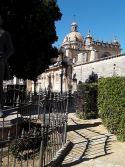
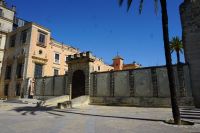 Perhaps it’s just as well that we are enjoying where we are, which seems far indeed. We left Jerez earlier today for Seville, having seen the three biggest sites in Jerez, a city of 200,000 that has its roots in Phoenician, Roman, Muslim, Spanish cultures and histories. The Phoenicians left nothing except stories about Hannibal and Carthage, and vineyards. The legacy was one of the main crops of al-Andalusia (named for the Muslim influence, which lasted from 711 until the 13 th century, when Alfonso the Wise, so-named because he knew at least three languages, which made him wise at the time, reconquered this part of Spain from the Muslims). The soil apparently is excellent for a white grape that lends itself to sherry, and on the hill that
Perhaps it’s just as well that we are enjoying where we are, which seems far indeed. We left Jerez earlier today for Seville, having seen the three biggest sites in Jerez, a city of 200,000 that has its roots in Phoenician, Roman, Muslim, Spanish cultures and histories. The Phoenicians left nothing except stories about Hannibal and Carthage, and vineyards. The legacy was one of the main crops of al-Andalusia (named for the Muslim influence, which lasted from 711 until the 13 th century, when Alfonso the Wise, so-named because he knew at least three languages, which made him wise at the time, reconquered this part of Spain from the Muslims). The soil apparently is excellent for a white grape that lends itself to sherry, and on the hill that 
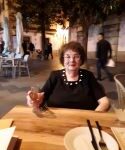 commands the city, one of the wine bodegas is Gonzalez Byass, makers of Tio Pepe, the largest selling brand, and the most visited vineyard in Spain.
commands the city, one of the wine bodegas is Gonzalez Byass, makers of Tio Pepe, the largest selling brand, and the most visited vineyard in Spain.
I did my part, touring the facility, which included sampling four varieties. Mr. Gonzalez was a banker turned wine-grower (at 23) who took on Mr. Byass, an English financier, as a partner, and the two families, now in the sixth generation, 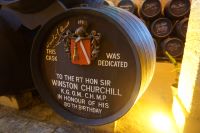 still run the company. It owns and sells a variety of wines around the globe, including Chilean, and some brandies. I was a little surprised to learn that sherries do not get packaged by year because it is a blended mixture, and can age up to 20 years—the older, the sweeter—like people, n’est ce pas?
still run the company. It owns and sells a variety of wines around the globe, including Chilean, and some brandies. I was a little surprised to learn that sherries do not get packaged by year because it is a blended mixture, and can age up to 20 years—the older, the sweeter—like people, n’est ce pas?
The second edifice on the hill that overlooks the city was the symbol of political power—the Alcazar. Apparently two Muslim dynasties ruled the 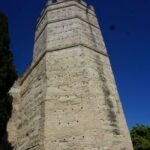 city, and each was responsible for establishing part of the Alcazar (if it starts with an al—it’s probably Islamic). The Alcazar was residence/fortress of th
city, and each was responsible for establishing part of the Alcazar (if it starts with an al—it’s probably Islamic). The Alcazar was residence/fortress of th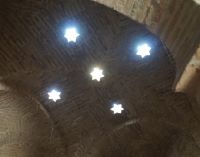 e rulers. Much of it is restored—the horseshoe archway, the three room baths—hot, cold, and ablution—with star-like holes in the dome to remind the Muslims of their desert heritage, a small mosque (that became a chapel), and square ramparts and towers that proved the best views of the town. There’s also a garden and some pools, along with orange trees whose fragrance fills the air. The Alcazar became the residence of the mayor, one of whom built an 18th century baroque palace within it that somehow works with the Muslim architecture.
e rulers. Much of it is restored—the horseshoe archway, the three room baths—hot, cold, and ablution—with star-like holes in the dome to remind the Muslims of their desert heritage, a small mosque (that became a chapel), and square ramparts and towers that proved the best views of the town. There’s also a garden and some pools, along with orange trees whose fragrance fills the air. The Alcazar became the residence of the mayor, one of whom built an 18th century baroque palace within it that somehow works with the Muslim architecture.
Across from the Alcazar, and built on the site of the Mosque (winners can do that) is the basilica, a huge cathedral in its second version. The tower from the first remained after (I think) an 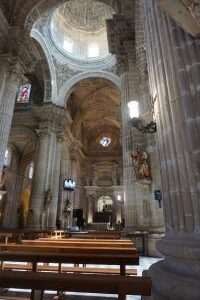
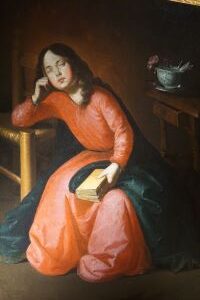 earthquake, and the rebuild was mostly gothic/baroque, two of my favorite church styles. Some of the altars and paintings came from convents and monasteries that were at one point or another confiscated. The main painting is a Zurbaran of a young Mary (late 16th century). When Pope John Paul II visited here in 1980, he elevated the cathedral to a basilica, meaning it’s the seat of the bishop.
earthquake, and the rebuild was mostly gothic/baroque, two of my favorite church styles. Some of the altars and paintings came from convents and monasteries that were at one point or another confiscated. The main painting is a Zurbaran of a young Mary (late 16th century). When Pope John Paul II visited here in 1980, he elevated the cathedral to a basilica, meaning it’s the seat of the bishop.
The three main sites were within easy walking distance from our hotel—enshrining religion, political power, and money at the time. We’re now in Seville, about 90 miles away, with another interesting story to tell, beginning with the name of our hotel, which is how I’ll start tomorrow night’s blog.
January 5-6, 2020
We’ve spent the past two days exploring four more Mayan sites. Though the Mayans occupied the area for over 1000 years (roughly 200 BC until 1400 AD), and left over 1500 known cities, the five (counting Palenque) we visited spanned most of the entire period.
 The biggest ruins in the Yucatan might well belong to those at Chichen Itza, or at least the most excavated and most visited. Up to 19,000 visitors a day arrive by the busload during peak season (last week), and it seemed like there were that many when we were leaving. We got there shortly after the park opened at 800, so there were still a few spots left in the parking lot. That did not last long. I can understand the fascination with a site labeled as one of the seven wonders of the modern world.
The biggest ruins in the Yucatan might well belong to those at Chichen Itza, or at least the most excavated and most visited. Up to 19,000 visitors a day arrive by the busload during peak season (last week), and it seemed like there were that many when we were leaving. We got there shortly after the park opened at 800, so there were still a few spots left in the parking lot. That did not last long. I can understand the fascination with a site labeled as one of the seven wonders of the modern world.
Our hotel there had a main entrance that was part of a hacienda purchased by Edward Thompson, American vice consul in Merida, who was responsible for some of the early excavations—and the man who used his diplomatic pouch to secret a number of artifacts to the Harvard Peabody Museum. Harvard won a battle waged by the Mexican government to get the material returned. The Mexican supreme court ruled that the laws at the time were inadequate to protect the nation’s treasures, so Harvard could keep the items; in a gesture of gratitude, some of the materials were returned. Mr. Thompson himself was hounded out of Mexico, however, and the hacienda sold to archeologists who built cabins, one of which was occupied by Mr. & Mrs. Hoyt.
Like most of the excavated sites, only a small portion of any of the sites has been recovered or restored. Given time, the jungle wins, or the cost of recovery is enormous. Coba, were we visited today, for example, spanned 40 square kilometers. Less than 15% is restored.
 Chichen Itza is classic period—about 1000 AD—which means the buildings were architecturally and artistically at their peak. The city-state was one of the most dominant, controlling as it did, one of the ancient world’s most important products—salt–until drought and population pressure eroded its sway.
Chichen Itza is classic period—about 1000 AD—which means the buildings were architecturally and artistically at their peak. The city-state was one of the most dominant, controlling as it did, one of the ancient world’s most important products—salt–until drought and population pressure eroded its sway.
The pyramid is 42 meters high, one of the highest, built atop an earlier version which contained a tomb whose finery now graces the national museum. My favorite buildings, though, were the ball court, the largest known with a “hoop” about 15 feet off the ground (try and dunk that); a ritualistic altar with thousands of skull figures (the macabre idea borrowed apparently from the Toltecs in central Mexico; the popular but apocryphal story is that the losers were 
 decapitated); the observatory (the Mayans, like most successful agricultural civilizations placed great emphasis on the rain god and were adept astronomers and astrologers; the construction of the observatory allowed stargazing even during the day); the temple of 1000 warriors, with a jaguar god atop, and 1000 pillars that for all the world looks like something borrowed from a Roman movie set; and, bless the Spanish, two buildings named by them, the “nunnery” and the “church,” older buildings with some of the best intact steles and bas-relief that we’ve seen.
decapitated); the observatory (the Mayans, like most successful agricultural civilizations placed great emphasis on the rain god and were adept astronomers and astrologers; the construction of the observatory allowed stargazing even during the day); the temple of 1000 warriors, with a jaguar god atop, and 1000 pillars that for all the world looks like something borrowed from a Roman movie set; and, bless the Spanish, two buildings named by them, the “nunnery” and the “church,” older buildings with some of the best intact steles and bas-relief that we’ve seen.
Partly because of the crowds and the wear and tear, none of the buildings is readily accessible. That’s probably a good thing because the pyramid has 365 steps (the Mayans knew the days of the year). Carolyn is super impressed with any civilization that reveres jaguars. We did see two jaguar crossing signs on the way to Cancun.
 Ek Balam, the jaguar city, was older (pre-classic period) and easily combined in one day with Chichen Itza. The site had an unusual rounded building and some excavated common folk housing—all ten feet per room
Ek Balam, the jaguar city, was older (pre-classic period) and easily combined in one day with Chichen Itza. The site had an unusual rounded building and some excavated common folk housing—all ten feet per room —that we saw nowhere else. I liked the reconstructed Mayan “arch” at the gateway to the city, which was triangular. The road there was full of pilgrims, many on bicycles, heading to a Church of the Three Wise Men, since Monday, the day of the arrival of the three wise men, is the gift-giving day associated with Christmas in Mexico.
—that we saw nowhere else. I liked the reconstructed Mayan “arch” at the gateway to the city, which was triangular. The road there was full of pilgrims, many on bicycles, heading to a Church of the Three Wise Men, since Monday, the day of the arrival of the three wise men, is the gift-giving day associated with Christmas in Mexico.
Today’s visits were to Coba and Tulum, two later (post classic; Tulum, in fact, lasting until the Spanish explorations, which was unusual for the Mayans). Coba, as mentioned, occupied 40 square kilometers, and even though only a small portion is excavated, those buildings are sufficiently scattered that we had a trishaw with a driver to take us around. Our guide noted that the workmanship deteriorated, but it was hard to tell in a city that had two ball courts (American and National League?), and a pyramid taller than the one at Chichen Itza (but unrestored).

 The most stunning site was Tulum, settled for a long time, but come to prominence late—stunning because of its location on the coast. Apparently, it was sort of a customs station or duty-free shop for Mayans along the coast, protected by a wall on 3 sides and steep cliffs down to the ocean on the fourth side. Large iguanas willingly posed for pictures, but the buildings
The most stunning site was Tulum, settled for a long time, but come to prominence late—stunning because of its location on the coast. Apparently, it was sort of a customs station or duty-free shop for Mayans along the coast, protected by a wall on 3 sides and steep cliffs down to the ocean on the fourth side. Large iguanas willingly posed for pictures, but the buildings 
 atop the hills—again, some of them resembling Roman ruins because of the pillars used to hold up a (no longer there) wooden roof. The most unusual of the gods was an upside-down man, facing west—the direction of the setting sun.
atop the hills—again, some of them resembling Roman ruins because of the pillars used to hold up a (no longer there) wooden roof. The most unusual of the gods was an upside-down man, facing west—the direction of the setting sun.
Given that the palaces of the Mayan rich were much nicer than the (mostly unexcavated) hovels of the poor, it’s fittingly ironic that our last night is being spent in Cancun, in one of those updated 21st century palaces.

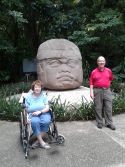 January 4, 2020
January 4, 2020
If you think—and some of you I know do—that I’ve got a big head, you should see some of the statues we’ve been looking at today.
They’re from the Olmec civilization, circa 1200-200 BC. You can find them in lots of places; we first did a year ago, at the National Archeological Museum in Mexico City. That’s really a great introduction to Mesoamerica because, as the nation’s major museum, it got first crack at most of the art (that didn’t wind up in Europe or the United States). There are, however, enough Mesoamerican artifacts to fill more than one museum.
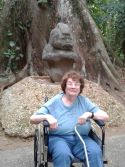
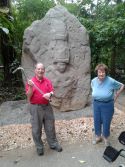
For example, you can spend an afternoon in Villahermosa (literally, beautiful city), a town of some 700,000, the capital of the state of Tabasco (known in Mexico as the birthplace of President Amlo—not Tabasco sauce which is I recall a product of Louisiana imagination). Here, a very imaginative poet conceived of moving the Olmec ruins from inaccessible La Venta to an accessible park in the city which housed a natural history museum, an aquarium, a planetarium, a zoo, and a host of other institutions, which now includes an archeological park of some 40 Olmec statues, altars, and plinths set in the lush jungle.
The enormous heads draw speculation on the transport of tons of stone because the Mesoamericans did not have wheels. And yet…basalt and sandstone in particular, with ten foot heads were transported (my favorite guess was using whale grease), paving the way, so archeologists argue, for the later Mayans, the bas-reliefs giving rise to later steles, and some of the art patterns repeated for the next 12-1500 years by their successors (and adopted by THEIR successors, the Aztecs, and their successors, contemporary Mexicans).
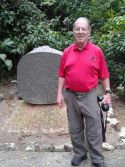 The Olmec area seems to have been in the Yucatán/Guatemala/Honduras jungles, and the artifacts in the park cover about 500 years, mostly from La Venta. I had to take pictures of Carolyn with the “Grandmother”, and myself with “The Walker,” but the most stunning items besides the big heads are the altars, usually with a man/bird/jaguar/crocodile half emerging
The Olmec area seems to have been in the Yucatán/Guatemala/Honduras jungles, and the artifacts in the park cover about 500 years, mostly from La Venta. I had to take pictures of Carolyn with the “Grandmother”, and myself with “The Walker,” but the most stunning items besides the big heads are the altars, usually with a man/bird/jaguar/crocodile half emerging from a cave (the underworld). The eagle carried the sun during the day (and is part of the Mexican flag), and the jaguar carried the sun through the netherworld at night.
from a cave (the underworld). The eagle carried the sun during the day (and is part of the Mexican flag), and the jaguar carried the sun through the netherworld at night.
From Villahermosa, our trek meant a short flight to Merida, capital of the Yucatan (and purportedly Mexico’s safest city) and then an hour and a half ride to Chichen Itza, where tomorrow we get the advanced course in all things Mayan.
January 3, 2020
We’re only 58 miles (as the crow flies) and 6200 feet lower than we were yesterday, but getting from the colonial charm of San Cristobal and its nearby Mayan descendants to the classical Maya ruins at Palenque was almost a six hour trip. Part of that was the descent which followed a lot of ridgelines, which meant curved type C roads (meaning usually not wide enough to pass, at least in theory); part of the delay was from topes—speed bumps. Our driver/guide said on one trip he counted the number, and it was 259, but that needs to be updated. The speed bumps not only replace stop lights and stop signs in towns as ways to slow traffic at important junctures (school crossings for example), but enterprising shopkeepers have them built up daily to encourage traffic to stop for bananas, the omni-present coke, or pollo (chicken), or gasoline or….
 Part of the length of the trip came from a short side trip to Aqua Azul, a national park (meaning three toll booths) to view cascades on the local river that is known for its blue green water during the dry season (now) and its muddy turbulence during the rainy season.
Part of the length of the trip came from a short side trip to Aqua Azul, a national park (meaning three toll booths) to view cascades on the local river that is known for its blue green water during the dry season (now) and its muddy turbulence during the rainy season.
It was worth the drive down through at least three ecosystems, starting with pine and ending with humid jungle (there are howler monkeys sharing the resort we’re at with us); Palenque has a well-deserved reputation as one of the top ruins in the Mayan period, and with reason.
While the settlement began about 100 BC, the heyday was during the reigns of King Pakal, his son, and grandson, in the 8th century (700-800 or so). Pakal was a successful warrior, and constructed buildings that were artistic monuments to his success. And he lived to be 80 years old, unheard of at the time, and was thought to possess magical powers because of a deformed leg.
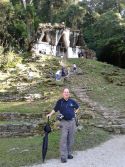 The temples/tombs/palaces, which comprise the majority of the excavated sites (a small portion of the site) mark the architectural highlights of the classic Mayan period (700-900). The buildings are mostly pyramid shaped, towering probably 150 high, at one time embracing a city of maybe 100,000 people. There’s a tomb for Pakal, his official wife (the Red Queen, so named because of the cinnabar sprinkled on her), an unexcavated Jaguar temple (something like 20 temples have been excavated, or at least named; as I saw in Cambodia, left alone, the jungle always wins), and a huge palace with an underground stream forced to go through a narrow passage and thus speeded up to the point where it had enough pressure to supply the palace with running water.
The temples/tombs/palaces, which comprise the majority of the excavated sites (a small portion of the site) mark the architectural highlights of the classic Mayan period (700-900). The buildings are mostly pyramid shaped, towering probably 150 high, at one time embracing a city of maybe 100,000 people. There’s a tomb for Pakal, his official wife (the Red Queen, so named because of the cinnabar sprinkled on her), an unexcavated Jaguar temple (something like 20 temples have been excavated, or at least named; as I saw in Cambodia, left alone, the jungle always wins), and a huge palace with an underground stream forced to go through a narrow passage and thus speeded up to the point where it had enough pressure to supply the palace with running water.
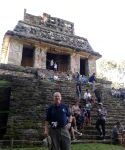
I was really glad that we’d gone to Mexico City last year and visited the National Archeological Museum there, because some of the choice relics are there—in particular the jade death mask of Pakal. The highlight in the museum here is a replica of the sarcophagus of Pakal, a huge box with elaborate stone bas reliefs that have some of the best-known glyphs of the period.

Our host at the resort is an Italian/German who studied Mayan linguistics and he told us that the writing was initially translated by a Russian (as part of the cold war efforts to find things useful to intelligence) while Westerners were slower to decipher the writing. The big push came in the ’90s, and he estimated about 85% of the script can be read. As a result, we know much about the Mayans.
I’m struck again at the similarities between the Mesoamericans and the Cahokia mound builders. For example, the classic birdman piasa stone looks like something out of Mayan central casting, and the pyramid in Cahokia is a pale earthen copy of the Mayan ruins. I suppose what it shows is that even before the internet and air travel, there was cultural sharing in the Americas, perhaps even more than there is today.
January 2, 2020
Carolyn’s desire to see more pre-Columbian ruins led us to the village of San Cristobal de las Casas, high in the mountains in southern Mexico. We’re at 6600 feet, 16 degrees north of the Equator, in another charming colonial village of about 450, 000 people. The village dates from 1528, with some of the historical buildings dating 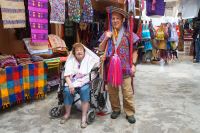
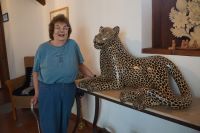 to the 16th and 17th century, and the old historic district chock full of one story buildings in pastels, with iron bars on windows, and lots of charming residences and shops restored as hotels (we’re in the Casa San Lucia, with antiques, paintings, and jaguar statues), shops, or restaurants, and narrow cobbled streets full of tourists and locals.
to the 16th and 17th century, and the old historic district chock full of one story buildings in pastels, with iron bars on windows, and lots of charming residences and shops restored as hotels (we’re in the Casa San Lucia, with antiques, paintings, and jaguar statues), shops, or restaurants, and narrow cobbled streets full of tourists and locals.
You can tell the locals, since Chiapas state is storied. Once administered as part of Guatemala under the Spanish, the state opted to join Mexico in 1824, shortly after independence. Its subsequent history has been sometimes troubled, since the indigenous Indians have had the short stick ever since the Spanish invasion. There were a number of uprisings, most recently in the 1990s, that brought federal troops to crush the Zapatistas, but really led to more autonomy for the 8 local tribes, descendants of the Mayans and still speaking languages that are closer to what they spoke in 900 than to Spanish.
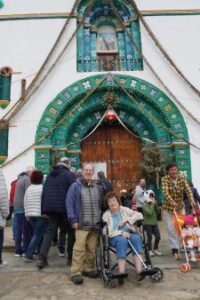 We went to two of those semiautonomous villages today, San Juan Chemula, and Zincantan. The centerpiece of both were the churches, with a big difference. In Chemula, the arch over the church is decorated with animals and butterflies, rather than Saints. Inside, the locals were having a service with the village elders in white tunics and the religious clergy in black praying for the entire community. Locals came with their family to hire a holy person to pray for them, and brought offerings, including live chickens to be sacrifices (and turned into chicken soup), and coke and other carbonated drinks to induce a burp and chase away evil spirits. I read somewhere that the church no longer considers the building “Catholic,” and I can only imagine how the Dominicans (they who not only settled and evangelized here, but also brought the Inquisition to the New World) would respond.
We went to two of those semiautonomous villages today, San Juan Chemula, and Zincantan. The centerpiece of both were the churches, with a big difference. In Chemula, the arch over the church is decorated with animals and butterflies, rather than Saints. Inside, the locals were having a service with the village elders in white tunics and the religious clergy in black praying for the entire community. Locals came with their family to hire a holy person to pray for them, and brought offerings, including live chickens to be sacrifices (and turned into chicken soup), and coke and other carbonated drinks to induce a burp and chase away evil spirits. I read somewhere that the church no longer considers the building “Catholic,” and I can only imagine how the Dominicans (they who not only settled and evangelized here, but also brought the Inquisition to the New World) would respond.
San Cristobal brought wheat and wood as its contributions to Spain, and that led to the settlement’s prosperity for the non-indigenous peoples. The area is still a rich agricultural region (Zincantan greeted us with enormous greenhouses) but tourism, I suspect, is what keeps this region green.
Originally called Ciudad Real, it was renamed after independence in honor of St. Christopher, protector of travelers, and I think the Saint’s day when the Spanish founded the city, and became de las Casas in honor of Bartholomew de las Casas, an early bishop that did his best to end Indian slavery, and whose statue embellishes one of the major squares in the city.
We spent some time sightseeing—the colonial square with the (smaller) copy of the government headquarters on one end of the main square, the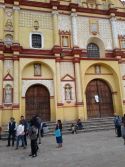 cathedral resplendent as so much of the city in pastels, and a visit to a museum that was once the Dominican
cathedral resplendent as so much of the city in pastels, and a visit to a museum that was once the Dominican 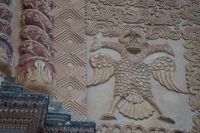 Monastery (all church property was confiscated by the federal government in the 1860s; it is sometimes loaned today to the churches) that included some of the artifacts found by the foreign archeologists who made San Cristobal home.
Monastery (all church property was confiscated by the federal government in the 1860s; it is sometimes loaned today to the churches) that included some of the artifacts found by the foreign archeologists who made San Cristobal home.
Tomorrow we descend to the jungle for the massive ruins of Palenque, which was one of the main objectives of this trip.
 Carolyn insists that a game drive is “like a box of chocolates,” but after six drives at Sabi Sabi (not counting the ride to Skukaza airport which went through the Sabi Sands game preserve, which resembled another one), I’m not entirely persuaded.
Carolyn insists that a game drive is “like a box of chocolates,” but after six drives at Sabi Sabi (not counting the ride to Skukaza airport which went through the Sabi Sands game preserve, which resembled another one), I’m not entirely persuaded.
Her point is that “You never know what you’re going to see.” I think that’s one of the best things about game drives. On that topic, I’m a “chocoholic.” Any animal you see (that you don’t see at home in the wild) is chocolate. And you always see something.
Carolyn was right: you never know what you’re going to see, or where you’re going to see it. Sabi Sands, a huge game reserve that’s adjacent to Kruger National Park is known for its abundant leopard population, even though it’s a pretty solitary animal. We chanced upon one that was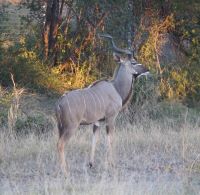 sauntering along the road, heedless of the safari
sauntering along the road, heedless of the safari  vehicle. We experienced another advantage of being in a private reserve when heading back in the dark, we spotted a leopard bent on something. And we followed through
vehicle. We experienced another advantage of being in a private reserve when heading back in the dark, we spotted a leopard bent on something. And we followed through 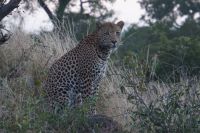 the bush until the leopard stopped for a drink in a pond just outside the warden’s fence.
the bush until the leopard stopped for a drink in a pond just outside the warden’s fence.
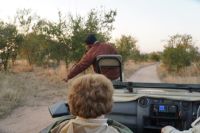 In Sabi, a crew of two mans the Land Cruisers. One is the driver, driving on mostly unpaved roads (at best). In a seat in front sits the “tracker” (another childhood dream), scanning for signs of wildlife. Our tracker, with a spotlight, saw a chameleon about 50 feet away in the dark and brought him back to show
In Sabi, a crew of two mans the Land Cruisers. One is the driver, driving on mostly unpaved roads (at best). In a seat in front sits the “tracker” (another childhood dream), scanning for signs of wildlife. Our tracker, with a spotlight, saw a chameleon about 50 feet away in the dark and brought him back to show 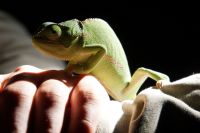 us. The tracker also helped the driver as we set to follow the leopard in the dark over hill and dale.
us. The tracker also helped the driver as we set to follow the leopard in the dark over hill and dale.
 I did take a nature walk, accompanied by two of the driver/rangers, armed with an elephant gun and five bullets (that’s what it takes to kill a rogue elephant), where they showed us plants, including the amarula tree that produces a liqueur that is a match for
I did take a nature walk, accompanied by two of the driver/rangers, armed with an elephant gun and five bullets (that’s what it takes to kill a rogue elephant), where they showed us plants, including the amarula tree that produces a liqueur that is a match for 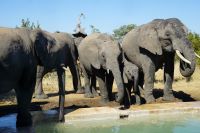 Bailey’s. Elephants like the pulp of the fruit, too, and will trample the area under the female tree—it’s the only one that produces the fruit—in their enormous appetite for almost everything green (we examined elephant and rhino poop and compared what they’d eaten).
Bailey’s. Elephants like the pulp of the fruit, too, and will trample the area under the female tree—it’s the only one that produces the fruit—in their enormous appetite for almost everything green (we examined elephant and rhino poop and compared what they’d eaten).
The “chocolate” included hyenas, jackals, the African civet cat, the genet—I think you get the picture.
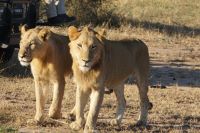 But the reason I think it’s not like a box of chocolate is because you can’t “eat” the box, but you can certainly devour the outdoors. The bush, dry in winter, extends across the horizon as far as you can see. So even if you don’t spot the big five, you’re left with an awesome sight.
But the reason I think it’s not like a box of chocolate is because you can’t “eat” the box, but you can certainly devour the outdoors. The bush, dry in winter, extends across the horizon as far as you can see. So even if you don’t spot the big five, you’re left with an awesome sight.
Then, too, the packaging at Sabi Sands includes the lodges. Well known for their luxury, we were at one that was top of the line-the Earth Lodge. Featured in National Geographic’s list of unique lodges, the individual 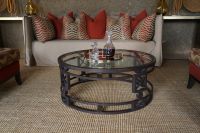 rooms were billed as being “the Future.” Dug into the earth, and covered over with dirt, creating a cave-like effect, the earth tones inside were fitting in well with the environment. We had the Presidential Suite, which was so big that I think the whole presidential party, including the foreign service, could have fit in it. Two
rooms were billed as being “the Future.” Dug into the earth, and covered over with dirt, creating a cave-like effect, the earth tones inside were fitting in well with the environment. We had the Presidential Suite, which was so big that I think the whole presidential party, including the foreign service, could have fit in it. Two 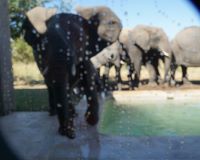 bathrooms, a full kitchen, a study, a living room, with really nice touches inside. The most impressive, to us, was a pool in front of the bedroom window where elephants came to drink at all hours. As we watched, several playfully (I hope) sprayed our windows before they went on their way.
bathrooms, a full kitchen, a study, a living room, with really nice touches inside. The most impressive, to us, was a pool in front of the bedroom window where elephants came to drink at all hours. As we watched, several playfully (I hope) sprayed our windows before they went on their way.
So, yes, Carolyn, it’s like a box of chocolate, but better. And now we have to figure out how to leave Earth Lodge and come back to Earth and Bloomington Illinois.
There’s gold in them hills
May 19, 2019 Sabi Sabi
We spent yesterday exploring Johannesburg, and, in the process, learning about the history, which, as in many other countries, helps explain the present (and the challenges of doing business there). Johannesburg is a late 19th century city, founded on gold. As I’ve mentioned, that gold helped shape South Africa in more ways than one. The Boers, who had left the Cape Colony partly because the British had abolished slavery, settled two new Boer states—the Orange Free State and the Transvaal.
The discovery of gold brought in an influx of non-Dutch miners. President Paul Kruger engineered legislation taxing the foreigners, but denying them the vote. It was one of the pretexts the British seized upon to pressure the Boers, who declared war and essentially fought the British empire to a standstill; the truce which ended the conflict was the beginning of the Union of South Africa. Thus, what is now South Africa (as opposed to the Cape Colony), started in Johannesburg. It’s now over seven million people, and while only 8 of the 30 or so mines that once gave the world over 2/3 of its gold are still functioning, many barely, the slag piles that resemble yellow mountains around the city can now be mined profitably with new technology—and sometimes yield uranium, platinum, and manganese. Thus, there is gold in them hills, still. The mines, as I mentioned, also fostered the race relationship that eventually hardened into apartheid, the rigid separation of the races. The Union of South Africa in 1910 began the process; middle class Blacks had been able to vote in the Cape Colony, for example. The Union took that vote away from all Black people. As apartheid reached its peak after World War II, the system became law.
We learned about the evolution of apartheid at the Apartheid Museum in Johannesburg. Ironically, the museum has a connection with gold, too. It’s located next to a theme park, Gold City, and a casino, that are on the site of the original gold mine. The concessioners got the right to build the casino in exchange for constructing the museum documenting apartheid. When you enter, you randomly get a ticket identifying you as white (Blankie in Afrikaan) or colored (non-white) and you enter the appropriate gate for the first exhibit, which gives you an idea of what apartheid was like.
Actually, as our guide pointed out, there were five “classes” of races. Northern Europeans were in class 1; in class 2 were southern Europeans (Italians, Greeks, and Spaniards were not quite class 1); class 3 consisted of mostly Asians; and class 5 were Blacks. Class 4 were Blacks who changed their name to a Dutch variant. One such was Hector Peiterson, who was born Pitro, in the black township of Soweto (Southwest Township), once home for mine workers, now a neighborhood of 2.5 million Blacks, with six
whites—four priests and two NGO workers.
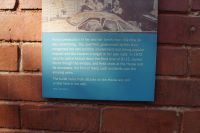
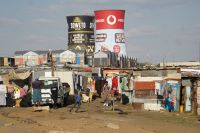 Soweto played prominently in Apartheid Museum. Nelson Mandela and Bishop Tutu, who won Nobel prizes for their work in ending apartheid, lived on the same street in Soweto. Mandela’s house is a tourist spot, complete with bullet holes from several police raids (he spent many years in the Robben Island prison, while his wife and daughters lived in the government-built house in Soweto; they added a brick wall between the kitchen and the living room so they could defend themselves from the random police violence).
Soweto played prominently in Apartheid Museum. Nelson Mandela and Bishop Tutu, who won Nobel prizes for their work in ending apartheid, lived on the same street in Soweto. Mandela’s house is a tourist spot, complete with bullet holes from several police raids (he spent many years in the Robben Island prison, while his wife and daughters lived in the government-built house in Soweto; they added a brick wall between the kitchen and the living room so they could defend themselves from the random police violence).
The Apartheid Museum documented the struggle to end apartheid, which got tangled up in the cold war. South Africa, being against communism, was helped by the United States in its war to keep Namibia and Angola from being taken over by political parties supported by Cuba, China, North Korea, and Russia. In fact, it was the CIA who told the South African government where Mandela was hiding, which led to his arrest and incarceration until 1990.
The Pieterson museum in Soweto focuses on one of the key events in the movement to end apartheid: a student uprising in Soweto. The target was to get a repeal of a white South African demand that all classes be taught in Afrikaans, the quasi-Dutch language of the Boers (and even today the second most spoken language in the country, but mostly by whites). The protest turned ugly, and between 67 (official) and 700 (unofficial) protesters were shot, the first being the twelve-year old Pieterson. It led to
a number of boycotts of South Africa by most other countries, and the isolation of the country internationally. In the effort to become self-sufficient, South Africa created businesses that were not competitive; when the bans were lifted when apartheid ended, it exposed a gap still plaguing the economy. Blacks had essentially been denied all opportunity for upward mobility.
To round out the story, we went through Johannesburg’s Central Business District, the old downtown. Once a prosperous white-dominated area, the city’s core suffered from violence and white flight, with many buildings having only shops of the first floor. We went to the SAB museum in the area, and our guide called the bus to take us the two blocks to AngloGold rather than let us walk it. In a lot of ways, the plight of South Africa is a function of its history. The government has built, we’ve been told, over 3.5
million homes, but needs to build 10 million more to end the shantytowns of containers converted with aluminum roofs. No wonder foreign investors are squeamish and South African bonds are mostly junk rated. That’s the cost of capital again!
There’s gold in them hills, but not all glitters.
Carolyn and I are experiencing the new “gold”…tourism, in one of the private game reserve parks. Our new best friends from the faculty development in business trip have mostly started their way back home. As you might have gathered from my blog, it was an enjoyable group and a great experience, capped last night by African dancers and an oxtail dinner. Now to deal with only animals….